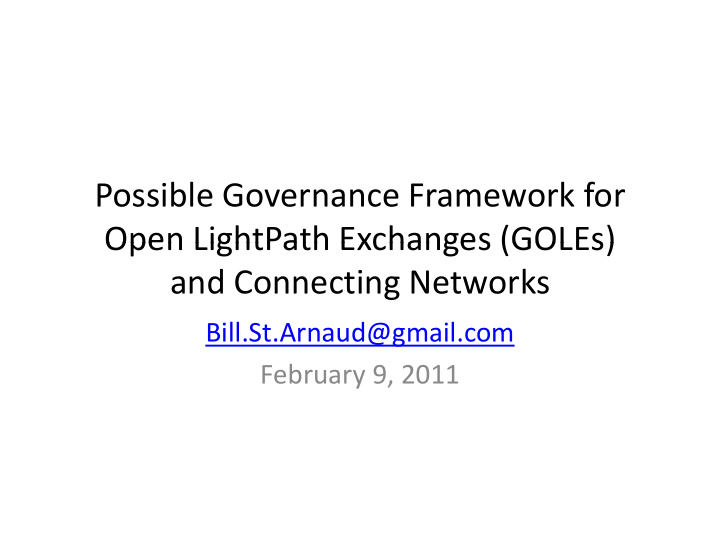



Possible Governance Framework for Open LightPath Exchanges (GOLEs) Open LightPath Exchanges (GOLEs) and Connecting Networks Bill.St.Arnaud@gmail.com February 9, 2011 February 9, 2011
Background Background Number of Open LightPath Exchange points increasingly significantly with • facilities in Asia Europe and North America facilities in Asia, Europe and North America Number of optical network connections between GOLEs also increasing • significantly g y New major eScience programs such as LHCONE will further favor • development of Open LightPath Exchange points New network initiatives from Internet 2, Renater, etc will further drive • demand for this type of infrastructure e.g. – Internet 2 proposed “distributed” lightpath exchange points Internet 2 proposed distributed lightpath exchange points – Renater optical network connection between Lyons and CERN Future global eInfrastructure will be built around open lightpath exchange • points and federated optical networks i t d f d t d ti l t k
History History GLIF has a governance working group addressing GLIF issues such as • funding organization etc funding, organization etc Individual GOLEs have advisory and technical committees • GLIF has developed best practices and documents for escalation and • service description No consistent practice at each GOLE in terms of support, responsibility, • funding, etc Inter GOLE lightpaths for the most part are owned by GOLEs and Inter ‐ GOLE lightpaths, for the most part are owned by GOLEs and • • access/policy established by GOLE at either end – In future may have a pool of “federated” inter ‐ GOLE lightpaths with common policy Many issues similar to creation of Internet after NSFnet wth establishment • of NAPs
Why Governance? Why Governance? As number of GOLEs increases and demand for lightpaths increases the • need to have some broad frameworks and policies becomes important need to have some broad frameworks and policies becomes important Governance framework will help minimize questions on AUP policies, • escalation procedures, who to contact, etc p , , Organizations may wish to donate resources such as international links to • a common “federated” pool of resources with a commonly agreed policy and who can use the resources priority of access etc and who can use the resources, priority of access, etc Governance body can address governments, external users, funding • agencies with a single voice and policy g g p y Governance can help provide input and direction to technical and • application committees
Governance does not mean central management or control l Open Lightpath exchanges and interconnecting links will be a “federation” • of exchange points and links of exchange points and links Some links and exchange points may be dedicated to a federated common • pool p Some links may be dedicated to specific community or VO e.g. LHC • “governance” in this framework refers to issues of governance of a • federation of resources – Similar concept to Eduroam or Internet “governance” No central organization manages or controls Internet or Eduroam • – Instead participants get together in technical and policy meetings to agree on how parties will interact to provide end to end solutions – Policy principles are agreement to support end ‐ to ‐ end principle, IPv6, etc P li i i l d d i i l IP 6
Some typical governance issues AUP at GOLES and optical links • Can commercial organizations get access? – Any restrictions on who can use GOLE or given lightpath? – Who can be a GOLE or what defines a GOLE? • Can commercial facilities be GOLEs? – Does a GOLE have to interconnect to other GOLEs? – What are “distributed” open lightpath exchange points? • How do they fit into the overall scheme ? – Who has access to lightpaths at a GOLE when demand exceeds supply – who gets Who has access to lightpaths at a GOLE when demand exceeds supply who gets • • priority? Tributary access connections to GOLEs usually controlled and managed by 3 rd party – What are the escalation procedures specifications and contact procedures for a What are the escalation procedures, specifications and contact procedures for a • • given GOLE? Should a GOLE be non ‐ blocking – Should a GOLE allow user owned boards? – Many GOLEs have different switches and equipment that are managed by separate • organizations with no consistent policies on access, etc Etc •
Further reading Further reading • SURFnet Position Paper for GEANT High Level p g Expert Group • http://www.surfnet.nl/Documents/SURFnet%20Position%20 Paper%20for%20GEANT%20High%20Level%20Expert%20Gr p g p oup.pdf – Presentation: • http://www.surfnet.nl/Documents/Presentation%20SURFne p // / / % t%20Position%20for%20GEANT%20High%20Level%20Expert %20Group.pdf • Bill St. Arnaud “Future Perspective on R&E p networks” • http://goo.gl/FxUsD
Recommend
More recommend